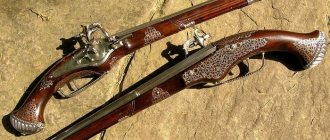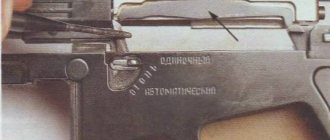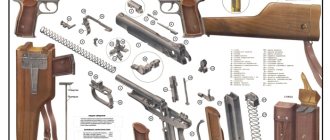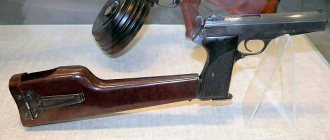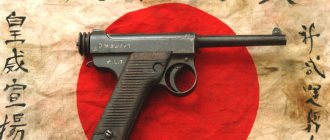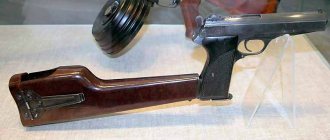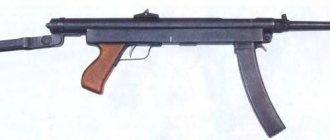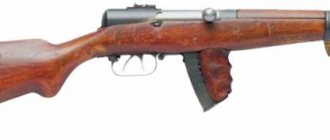The small-sized TK pistol was created in the early years of the USSR. According to some sources, the weapon was intended for sporting purposes, according to others - for pocket carry by NKVD officers. The third version refers to the need for civilian weapons, which were in demand by wealthy people of the NEP era.
In any case, it is a weapon of the S.A. system. Korovin became the first Soviet self-loading pistol to be produced in large quantities. The exact number of Korovin pistols collected is unknown; an abstract number of several tens of thousands of copies is usually indicated.
Development history
Soviet and Russian weapons developer S.A. Korovin was born in Kharkov. Soon after entering the Institute of Technology, he was accused of involvement in the activities of revolutionary cells and expelled. Failure did not break the young man, and he moved to Belgium, where he went to work in arms factories.
It is there that one gets acquainted with weapons, in particular with samples of the Browning system. Korovin's first development was an original trigger mechanism, for which there was a patent.
By the beginning of the First World War S.A. Korovin returns to Russia and attempts to start working at arms factories in Tula. The first attempt was unsuccessful, so the future designer was forced to work in Petrograd. He arrived in Tula only in 1920, and a year later he presented his first independent development - an automatic pistol designed to use 7.65 mm Browning cartridges.
Tests of prototypes showed ease of use and reliability of the design.
Due to the reorganization of the structure at the plant, the production of the first batch of pistols was delayed until 1927. The designer’s desire to independently resolve all issues that arose also contributed. In parallel, S.A. Korovin tried to create a “pocket” weapon equipped with self-cocking. But the design turned out to be oversized and heavy.
At the end of 1924, the designer began working on weapons ordered by the Dynamo sports society. The ammunition used was 6.35 mm Browning or Mauser cartridges. Serial production started in the fall of 1926, but official acceptance by the customer took place a year later.
The weapon was designated pistol TK (Tula Korovin) mod. 1926. Due to the fact that the pistol was a civilian and sporting weapon, it was marked with a non-military type mark. Later, the weapon received the GAU army index 56-A-112.
During the production process, the appearance of TK pistols changed. Thus, early versions used a front sight with sharp edges, beveled on the back. Later it was changed to a rounded one.
On the frame of the first Korovin pistols there was a recess designed to hold the fuse protrusion.
At the beginning of the 30s, the corrugation pattern on the shutter casing changed, which received a weighted structure; bakelite (occasionally gutta-percha) linings with rotary clamps were used instead of wooden parts fastened with screws. At the same time, the design of the frame did not change at first, which preserved the interchangeability of parts.
On the surface of the bakelite cheeks there is the abbreviation TOZ, which is why the weapon is called TOZ by this name abroad. Occasionally there are wooden cheeks with a longitudinal pattern, which differs from the standard rhombic version. Such parts are considered repair parts.
The production of the TK pistol continued until 1935; in parallel, the production of domestic 6.35 * 15.5 mm cartridges with a standard charge of gunpowder (GAU index 57-N-112) was carried out. The cartridges were discontinued only at the beginning of the war. A number of sources contain information about the enhanced charge of domestic cartridges.
But in the official technical documentation of plant No. 3 (named after Volodarsky, Ulyanovsk), which produced ammunition, there is no such data. The technical characteristics of the cartridge are given below.
| Parameter | Meaning |
| Cartridge weight, g | 5,3 |
| Chuck length, mm | 23 |
| Charge weight, g | 0,08 |
| Bullet weight, g | 3,2 |
| Initial bullet speed, m/sec | 228 |
Links
- M. R. Popenker. [https://world.guns.ru/handguns/hg/rus/korovin-tk-r.html Korovin TK pistol (USSR)] / website “Modern small arms of the world”
- [https://www.armoury-online.ru/articles/pistols/russia/Korovin/ Korovin TK pistol. History, design description, features, photos, performance characteristics on the website armory-online.ru]
- [https://www.megasword.ru/index.php?pg=124 Korovin Pistol (TK) on the website megasword.ru]
- [https://www.shooting-ua.com/arm-books/arm_book_67.htm Korovin pistol (TK). General information, disassembly, manual on shooting-ua.com]
- [https://www.arms-magazin.ru/images/2010-03/tirans/07.jpg 6.35 mm Korovin pistol, donated to Stalin by TOZ workers in 1928] (photo on arms-magazin.ru)
- [https://historypistols.ru/blog/pistolety-pod-unitarnyj-patron-avtomaticheskie/pistolet-korovina-tk-tulskij-korovina-635-mm// History of the appearance, design, assembly and disassembly procedure of the Korovin TK 6 pistol, 35] (TK pistol in photographs on historypistols.ru)
- [https://historypistols.ru/blog/pistolety-pod-unitarnyj-patron-avtomaticheskie/raznovidnosti-pistoleta-korovina-tk-635-mm/ Varieties of the Korovin TK 6.35 pistol] (Photo of various modifications of TK pistols on historypistols. ru)
Korovin 1941 submachine gun
Design
The Korovin pistol is a short-barreled weapon equipped with a trigger mechanism with a striker. The barrel is locked by the weight of the bolt and the return spring.
A number of weapon parts have a dual purpose, due to this it was possible to simplify the design and reduce the number of elements to 26 pieces (with complete disassembly).
To increase the weight of the shutter, its connection to the outer casing was used. To simplify manufacturing, the dimensions of the casing are reduced. The handle of Korovin’s pistol housed a replaceable box-shaped magazine designed to accommodate eight rounds. The ninth cartridge was in the chamber cavity.
The magazine lock is made in the form of a latch mounted on the lower end of the handle. There is a rotary safety on the left side of the frame that limits the movement of the trigger.
The front sight is made as a single unit with the barrel, the barrel bore has six rifling directed to the right side. The sighting device has no adjustments. The barrel part has a recess located closer to the chamber. The notch is used to rigidly connect the barrel and frame using the safety axis. There are grooves on the axis that are used to support the guide rod of the return spring. It is used to hold the safety in place and secure it in its extreme positions.
The frame is designed to hold and connect all parts of the weapon; it is made by casting followed by machining.
The return spring is mounted on a stem located under the barrel. The rear part of the cartridge ejector serves as an indicator device, informing about the presence of a cartridge in the chamber.
The main technical characteristics of the weapon are given below. The heavy weight of the weapon is noteworthy. Due to this, it was possible to provide a large resource of parts.
| Parameter | TK |
| Barrel length, mm | 67,5 |
| Length of the rifled section of the barrel, mm | 52 |
| Length, mm | 127 |
| Height, mm | 98 |
| Thickness, mm | 24 |
| Weight without cartridges/with cartridges, kg | 0,41/0,49 |
| Empty magazine weight, g | 33 |
The disadvantages of the Korovin pistol are the significant dispersion of bullets when firing, as well as the inconvenient ergonomics of the handle. The fuse had low reliability; there were cases of spontaneous shots due to the striker jumping off the combat platoon.
The designer's legacy
After a successful “T.K.” Sergei Aleksandrovich Korovin continued work on pistols. In 1928, his 7.65 mm pistol was tested together with Prilutsky and Walter pistols. Domestic weapons turned out to be better than German ones, but Prilutsky’s system, being simpler, was preferable. In 1929, Korovin and Prilutsky reduced the caliber of their weapons to 7.62 mm, but here their design lost to the system of F.V. Tokarev. In 1939 and 1941, Korovin again went out for testing with a pistol. The work was not in vain; our designers used shortcomings and mistakes to debug the models and design the best
And the role of Sergei Aleksandrovich Korovin in this work was important and noticeable
"T.K." in a holster
The Korovin pistol of the 1926 model can be safely called the first and only model of civilian short-barreled weapon in our country, which was developed from scratch, without using army models as a base. Both the cartridge and the size of the weapon were selected specifically for this application
Such a pistol is needed in order to fire several shots point-blank at an attacker and attract attention with noise. As a disadvantage of this pistol, they note the inconvenience of holding it: this is understandable - with such dimensions, the size of the handle simply cannot be larger. There are also complaints about the cocking being too tight and the firing pin spring failing quickly.
There are also complaints about the cocking being too tight and the firing pin spring failing quickly.
As a truly important problem with a pistol, only one can be noted - the bending of the housing and bolt during active use of the weapon. This defect is practically not described, which suggests that it does not have a serious impact on the functionality of the pistol. On worn pistols there is a problem with the supply of cartridges
On worn-out pistols, there is a disturbance in the supply of cartridges.
Shops to "T.K." One of the magazine options with an aluminum bottom
ARTICLE PUBLISHED IN NO. 1, 2013
Application and interesting facts
The Korovin pistol was used to a limited extent by members of the NKVD, as well as by the command staff of the Red Army. In addition, individual copies were awarded as award weapons to employees of internal affairs bodies, heads of large enterprises and design bureaus, as well as Stakhanovites. The pistol was not used as a self-defense weapon for civilians.
During the Great Patriotic War, some of the barrels that were in storage entered the active army. The weapon was used to arm junior command personnel (due to the shortage of the main TT pistol).
After the end of the war, Korovin’s pistol was used as a backup weapon for employees of State Bank branches or savings banks (including collectors).
The domestic cartridge size 6.35*15.5 mm appears in the film “The meeting place cannot be changed.” It was with this that the Bayard pistol that the doctor Gruzdev had was loaded.
The energy of Korovin’s pistol bullets was enough to guarantee through penetration of 2 pine boards 25 mm thick from a distance of 25 m. After this, the bullet half pierces the third board.
The commander of the 33rd Army, M.G., was armed with a Korovin pistol. Efremov during an attempt to break out of encirclement in the spring of 1942.
The reason for the short life cycle of the TK pistol was the low power of the cartridge and the lack of demand for this type of weapon in the USSR. The army used the pistol only during a period of acute shortage of more reliable and powerful TTs. Hitting a target with a 6.35 mm bullet did not guarantee the shooter's safety, since the attacker could strike back.
The only effective way to use a TK in combat was to shoot at the enemy’s head, which not every owner of a Korovin pistol was able to do. To date, many samples of weapons have been preserved, in varying states of preservation. But regardless of condition, the TK is a desirable acquisition for many gun collectors.
Photo of the TK pistol
Similar
AK-47 assault rifle cartridge caliber 7.62 mm. Device. Rate of fire
AK-74 assault rifle cartridge caliber 5.45 mm. Device. Rate of fire
Dragunov SVD sniper rifle caliber 7.62 mm. Device
AKS-74U assault rifle cartridge caliber 5.45 mm. Device. Weight
Mauser K96 pistol cartridge caliber 7.63 and 9 mm. Device
Pistol Walter PP / PPK cartridge caliber 7.65 and 9 mm. Device
Pistol Yarygin PYa Grach cartridge caliber 9 mm. Device
DShK machine gun cartridge caliber 12.7 mm. Device. Rate of fire
Luger pistol R.08 Parabellum cartridge caliber 9 mm. Device
Pistol PM cartridge caliber 9 mm. Rate of fire. Dimensions. Bullet speed. Sighting range
Self-loading shotgun Saiga-12 cartridge, caliber. Device
Maxim machine gun cartridge caliber 7.62 mm. Device. Weight
PPSh-41 Shpagina submachine gun cartridge caliber 7.62 mm
APS Stechkin pistol cartridge caliber 9 mm. Device
Nagan system revolver cartridge caliber 7.62 mm. Device
Kalashnikov PK machine gun and PKM cartridge caliber 7.62 mm. Device
Simonov carbine SKS-45 cartridge caliber 7.62 mm. Device
Rifles and carbines Mauser 98 caliber 7.92 mm. Device
PPS-42 and PPS-43 Sudaev submachine gun cartridge caliber 7.62 mm
Pistol Walter P38 cartridge caliber 9 mm. Device
MP-40 German submachine gun cartridge caliber 9 mm. Device
VSS Vintorez sniper rifle caliber 9 mm. Device
Submachine gun PP-91 Kedr cartridge 9 mm caliber. Device
Light machine gun RPK-74 cartridge caliber 5.45 mm. Device
Pistol Glock 17 cartridge caliber 9 mm. Device
Makarych, Izh-79-9T, MR-79-9TM, MP-80-13T traumatic pistol
AK-12 assault rifle cartridge caliber 5.45 mm. Device. Weight
Mosin rifles and carbines Three-line caliber 7.62 mm
PMM Makarov pistol modernized 12 rounds. Device
Revolver Colt Single Action Army (SAA) Peacemaker. Device
Machine gun PKP Pecheneg cartridge caliber 7.62 mm. Device
Sniper rifle VSSK Exhaust caliber 12.7 mm. Device
Beretta pistol 92 cartridge caliber 9 mm. Device
TT - Tokarev pistol cartridge caliber 7.62 mm. Device
Submachine gun PP-19 Bison cartridge caliber 9 and 7.62 mm. Device
Sniper rifle SV-98 caliber 7.62 mm. Device
Vladimirov KPV machine gun cartridge caliber 14.5 mm. Device
ASH-12 assault rifle cartridge caliber 12.7 mm. Device. Rate of fire
PSM pistol cartridge caliber 5.45 mm. Device
Pistol Colt M1911A1 cartridge caliber 45. Device
Smith-Wesson revolver Russian cartridge, caliber 10.67 mm. Device
Degtyarev DP-27 light machine gun, 7.62 mm caliber cartridge. Device
Shotgun Mossberg 500 Cartridge. Dimensions. Rate of fire. Sighting range
Thompson submachine gun cartridge caliber 11.43 mm. Device
Pistol USP Heckler und Koch cartridge, caliber. Device
Hunting carbine OSK-88 (SVT-40) caliber 7.62 mm. Device
AS Val silent automatic cartridge caliber 9 mm. Device
Submachine gun PP-19-01 Vityaz cartridge 9 mm caliber. Device
Machine gun Kord cartridge caliber 12.7 mm. Device. Weight. Sighting range
Osa - traumatic pistol cartridge, caliber. Device
AK-9 assault rifle cartridge caliber 9 mm. Device. Rate of fire
Degtyarev RPD light machine gun, 7.62 mm caliber cartridge. Device
Automatic OTs-14 Groza cartridge caliber 9 mm and 7.62 mm. Device
Czech pistol CZ-75 (modifications). Device
Browning pistol 1903 cartridge caliber 9 mm. Device
Sniper rifle OSV-96 caliber 12.7 mm. Device
FN P90 submachine gun cartridge caliber 5.7 mm. Device
Submachine gun OTs-02 Cypress cartridge caliber 9 mm. Device
Sniper rifle ASVK Kord caliber 12.7 mm. Device
Automatic AEK-971 Cartridge. Caliber. Device. Rate of fire
Steyr AUG assault rifle (A1, A2, A3) cartridge caliber 5.56 mm
AK series 100 assault rifles. Modifications. Device. Weight. Dimensions
Uzi submachine gun. Cartridge. Caliber. Rate of fire
Pistol SR1M Gyurza cartridge caliber 9 mm. Device
Pistol GSh-18 cartridge caliber 9 mm. Device
SVDK sniper rifle caliber 9.3 mm. Device
Automatic SR-3M Whirlwind cartridge caliber 9 mm. Device
Machine gun NSV-12.7 Utes cartridge, cal. Device. Weight
Kalashnikov RPK light machine gun cartridge caliber 7.62 mm. Device
Sniper rifle VSK-94 caliber 9 mm. Device
Vostok-1 (Jorge-3M) 9mm caliber traumatic pistol. Device
Degtyarev PPD submachine gun cartridge caliber 7.62 mm
English sniper rifle L96A1 cartridge, caliber
M1 Garand rifle cartridge caliber 7.62 mm. Device
Desert Eagle pistol. Device
Smith-Wesson revolver (modifications). Device
Automatic rifle HK G36 (E, K, C, KE) cartridge caliber 5.56 mm
Pistol P-96 cartridge caliber 9 mm. Device. Rate of fire
Pistol GP35 Browning High Power cartridge, caliber. Device
Assault rifle FN SCAR (L, H) cartridge caliber 5.56 and 7.62 mm
Revolver Lefoshe M1856 cartridge caliber 11 mm. Device
Submachine gun PP-90 cartridge caliber 9 mm. Device
AN-94 Abakan automatic Nikonov cartridge caliber 5.45 mm. Device
Submachine gun PP-2000 cartridge caliber 9 mm. Device
Mauser pistol HSc cartridge caliber 7.65 and 9 mm. Device
M16 automatic rifle cartridge caliber 5.56 mm. Device
Fedorov assault rifle cartridge caliber 6.5 mm. Device. Rate of fire
Pistol Baltiets cartridge caliber 7.62 mm. Device
Strizh pistol cartridge caliber 9 mm. Device. Weight. Sighting range
Browning pistol 1910 cartridge caliber 7.65 and 9 mm
Silent pistol PSS Vul cartridge caliber 7.62 mm. Device
Pistol SIG-Sauer P226 cartridge caliber 9 mm. Device
Pistol OTs-27 Berdysh cartridge caliber 7.62 mm and 9 mm. Device
AK-107 assault rifle cartridge caliber 5.45 mm. Device. Rate of fire
OTs-44 sniper rifle, caliber 12.7 mm. Device
German machine gun MG3 cartridge caliber 7.62 mm. Device
Self-loading shotgun Browning Auto-5 cartridge, caliber. Device
Submachine gun AEK-919K Kashtan cartridge caliber 9 mm. Device
PB pistol silent cartridge 9 mm caliber. Device
Pistol OTs-33 Pernach cartridge caliber 9 mm. Device
Hunting carbine KO-98 cartridge caliber 7.92 mm. Device
TK (Korovin pistol) caliber 6.35 mm. Device. Weight. Dimensions
Underwater assault rifle APS cartridge caliber 5.66 mm. Device
Pistol OTs-21 Malysh cartridge caliber 9 mm. Device
American M60 machine gun, 7.62 mm caliber cartridge. Device
MTs-116M sniper rifle, caliber 7.62 mm. Device
Automatic 9A-91 cartridge caliber 9 mm. Device. Rate of fire
Submachine gun PP-93 cartridge caliber 9 mm. Device
VAG-73 - Gerasimenko pistol. Device. Weight. Dimensions
Cordon-5 is a traumatic pistol. Device. Weight. Dimensions
Goryunov SG-43 heavy machine gun cartridge caliber 7.62 mm. Device
Webley revolver cartridge, caliber. Device. Dimensions. Weight
Machine gun AEK-999 Badger cartridge caliber 7.62 mm. Device
RP-46 machine gun, 7.62 mm caliber cartridge. Device. Rate of fire
Sniper rifle VS-8 cartridge caliber 8.6 mm. Device
Slostin machine gun cartridge caliber 7.62 mm and 14.5 mm. Device
Assault rifle Tavor TAR-21 cartridge caliber 5.56 and 5.45 mm
Submachine gun SR-2 Veresk cartridge caliber 9 mm. Device
Lancaster pistol cartridge caliber 12.1 mm. Device. Rate of fire
Submachine gun PP-90M1 cartridge caliber 9 mm. Device
Underwater pistol SPP-1M. Device. Weight. Dimensions
Traumatic pistol MP-461 Guard. Device. Weight. Dimensions
Lebel rifles and carbines are cartridgeed in 8 mm caliber. Device
Automatic A-91 cartridge caliber 7.62 mm. Device. Rate of fire
M14 automatic rifle cartridge caliber 7.62 mm. Device
Revolver Smith & Wesson Model 10 Military & Police
Automatic rifle FN FAL cartridge caliber 7.62 mm. Device
Submachine gun STEN MK 2. Device. Weight. Dimensions
Traumatic pistol IZH-78-9T Chain mail cartridge caliber 9 mm
Leader-M traumatic pistol 11.43×32T. Device. Weight. Dimensions
Ingram M10 and M11 submachine gun. Device. Weight. Dimensions
Pistol Steyr M9-A1 cartridge caliber 9 mm. Device. Weight
Pistol OTs-23 Dart cartridge caliber 5.45 mm. Device
Berthier rifles and carbines caliber 8 mm. Device
Automatic shotgun USAS-12 cartridge caliber 18.5 mm
Sniper rifle VS-121 caliber 7.62 mm. Device
Traumatic pistol MP-353 cartridge, caliber 11.43 mm
Tiss machine gun cartridge caliber 9 mm. Device. Rate of fire
Traumatic pistol MP-355 cartridge caliber 9 mm. Device
Automatic double-medium ADS cartridge caliber 5.45 mm. Device. Rate of fire
Traumatic pistol MP-81 cartridge caliber 9 mm. Device
Pistols Zastava 70 and 70(k), cartridge caliber 7.65 or 9 mm. Yugoslavia
Sniper rifle GALATZ (Galil) cartridge caliber 7.62 mm
Pistol MP-444 Bagheera cartridge caliber 9 mm. Device
Revolver Colt New Army / Navy. Device. Bullet speed. Sighting range
Type 64 is a Japanese automatic rifle. Device
Other Features
Due to the large mass of the bolt group (700 grams), as well as the bolt stroke of 143 mm, the PPK fired at a very low rate: only 470 rounds per minute. Unlike the PPSh, the name of which was deciphered by experienced front-line soldiers as “Shpagin’s cartridge eater,” Korovin’s product made it possible to use ammunition economically. Accustomed shooters even fired single shots from the weapon without any problems, which was impossible to achieve from the same PPSh from the war years.
In general, if we consider all the submachine guns of the Second World War, then only the American Thompson could shoot normally with single cartridges. It’s just that it cost hundreds of times more than even an “overly complex PPD,” let alone a cheap PPD that could be made practically from scrap metal.
A buttplate was attached to a folding wire buttplate (it could be rotated). Wooden cheeks were placed on the pistol grip of the weapon. Since this weapon in the “military” version did not have a forearm, the fighter held his hand on the magazine, made by cold stamping. Capacity – 35 rounds, staggered arrangement of ammunition. Like other Soviet weapons of this class, this Russian submachine gun used the standard Soviet cartridge of that time - 7.62x25.
